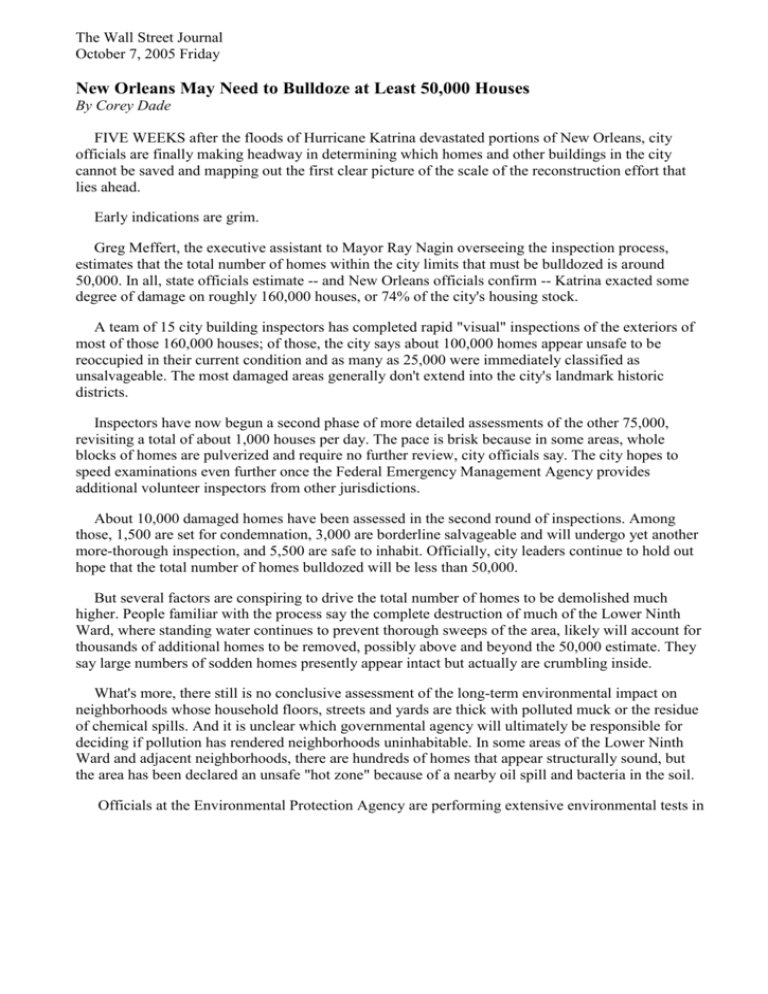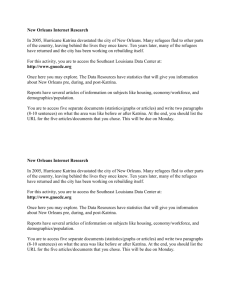
The Wall Street Journal
October 7, 2005 Friday
New Orleans May Need to Bulldoze at Least 50,000 Houses
By Corey Dade
FIVE WEEKS after the floods of Hurricane Katrina devastated portions of New Orleans, city
officials are finally making headway in determining which homes and other buildings in the city
cannot be saved and mapping out the first clear picture of the scale of the reconstruction effort that
lies ahead.
Early indications are grim.
Greg Meffert, the executive assistant to Mayor Ray Nagin overseeing the inspection process,
estimates that the total number of homes within the city limits that must be bulldozed is around
50,000. In all, state officials estimate -- and New Orleans officials confirm -- Katrina exacted some
degree of damage on roughly 160,000 houses, or 74% of the city's housing stock.
A team of 15 city building inspectors has completed rapid "visual" inspections of the exteriors of
most of those 160,000 houses; of those, the city says about 100,000 homes appear unsafe to be
reoccupied in their current condition and as many as 25,000 were immediately classified as
unsalvageable. The most damaged areas generally don't extend into the city's landmark historic
districts.
Inspectors have now begun a second phase of more detailed assessments of the other 75,000,
revisiting a total of about 1,000 houses per day. The pace is brisk because in some areas, whole
blocks of homes are pulverized and require no further review, city officials say. The city hopes to
speed examinations even further once the Federal Emergency Management Agency provides
additional volunteer inspectors from other jurisdictions.
About 10,000 damaged homes have been assessed in the second round of inspections. Among
those, 1,500 are set for condemnation, 3,000 are borderline salvageable and will undergo yet another
more-thorough inspection, and 5,500 are safe to inhabit. Officially, city leaders continue to hold out
hope that the total number of homes bulldozed will be less than 50,000.
But several factors are conspiring to drive the total number of homes to be demolished much
higher. People familiar with the process say the complete destruction of much of the Lower Ninth
Ward, where standing water continues to prevent thorough sweeps of the area, likely will account for
thousands of additional homes to be removed, possibly above and beyond the 50,000 estimate. They
say large numbers of sodden homes presently appear intact but actually are crumbling inside.
What's more, there still is no conclusive assessment of the long-term environmental impact on
neighborhoods whose household floors, streets and yards are thick with polluted muck or the residue
of chemical spills. And it is unclear which governmental agency will ultimately be responsible for
deciding if pollution has rendered neighborhoods uninhabitable. In some areas of the Lower Ninth
Ward and adjacent neighborhoods, there are hundreds of homes that appear structurally sound, but
the area has been declared an unsafe "hot zone" because of a nearby oil spill and bacteria in the soil.
Officials at the Environmental Protection Agency are performing extensive environmental tests in
New Orleans, and have repeatedly warned that certain areas aren't safe to re-enter. But the agency
says it isn't issuing opinions on which areas, if any, should be demolished. City officials say they are
focused on structural inspections, not environmental ones.
To fast-track storm-related demolitions, the city will exercise an exception in its municipal code
for structures in "imminent danger of collapse," requiring no notice to be given to property owners.
Mr. Meffert, whose oversight includes building-safety operations, says proposed condemnations will
be reviewed by the Historic Districts Landmark. He says buildings not found to be historic or
architecturally significant will be immediately scheduled for destruction.
"The city is only going to decide that which Katrina already demolished," Mr. Meffert says.
"That's what people need to know to get past this hysteria."
Restoring the city sewer system looms as perhaps the largest undertaking facing New Orleans.
The city's sewage-treatment plant on the East Bank was heavily flooded by Katrina. Scientists,
engineers and specialists from the EPA, the U.S. Geological Survey and the Louisiana Department of
Environmental Quality are jointly working with the city to restart the plant and get the complex
sewer system -- which relies on pumps to get sewage out of the below-sea-level city -- flowing again.
Those agencies say restarting the system could take three to four months. "It's going to be a pretty
significant engineering feat to bring this thing up," says Chris Piehler, a senior scientist with the
environmental-quality agency. "The city, for all practical purposes, has been de-watered, but there
are some other dynamics that are going to affect when people are going to be allowed to return."
Mr. Piehler says that once the wastewater-treatment plant is pumped dry, the roads leading to it
must be rebuilt. Then, the electronics, pumps and aeration units used to clean wastewater must be
replaced and the facility's steel supports examined for leaks. "That's just there at the plant," he said.
Throughout the city, pumps at lift stations that push waste to the treatment plant may be damaged.
For now, the city's pipes that are flowing are depositing raw sewage directly into the Mississippi
River. Since the largely depopulated city is producing dramatically less sewage than normal, Mr.
Piehler said the waste is diluted by the river and the environmental impact is "negligible."
However, the risk of pollution rises with the gradual return of the population. "What's OK with
100,000 people is not OK with 400,000," says Jean Kelly, spokeswoman for the state Department of
Environmental Quality. "What we're doing is to monitor so that the impact remains negligible."
The removal of debris -- cars, boats, hazardous household chemicals, such as paint thinner and
bleach, and trees --strewn across the city is expected to take as long as two years. Compounding the
enormous scale of sludge and objects large and small, state officials have struggled to find staging
areas in the city for their removal operations and identify enough acres of land in southeast Louisiana
where the debris can be properly disposed of.
But it's the fate of homes in New Orleans that remains the most emotionally wrenching aspect of
the reconstruction process. The city's inspectors continue working their way through the communities
in which Mr. Nagin has allowed re-entry, but they have barely penetrated the low-lying areas of
Lakeview and the Lower Ninth Ward, where some within city government privately say the difficulty
of navigating streets has made re-entry for the public impossible anytime soon.
Gay Rowe Fulton, who knows no other home than the "Lower Nine," watches others reclaim their
---
properties on TV from a Baton Rouge apartment. She was among the Ninth Ward natives who
attended a Baton Rouge briefing on Sept. 21 during which Mayor Nagin announced the re-entry
schedule for all other neighborhoods.
Mr. Nagin has said he understands the desires of Ninth Ward residents to return. "The Lower
Ninth Ward is a very complex situation," he said last week.
"Why not talk with us?" asks 61-year-old Ms. Fulton, who was appointed before Katrina to an
advisory committee to the mayor on senior citizens. "It's not like he doesn't know me; like he doesn't
know where I live."
--Betsy McKay contributed to this article.
--Copyright 2005 Factiva, a Dow Jones and Reuters Company
All Rights Reserved
(Copyright (c) 2005, Dow Jones & Company, Inc.)











